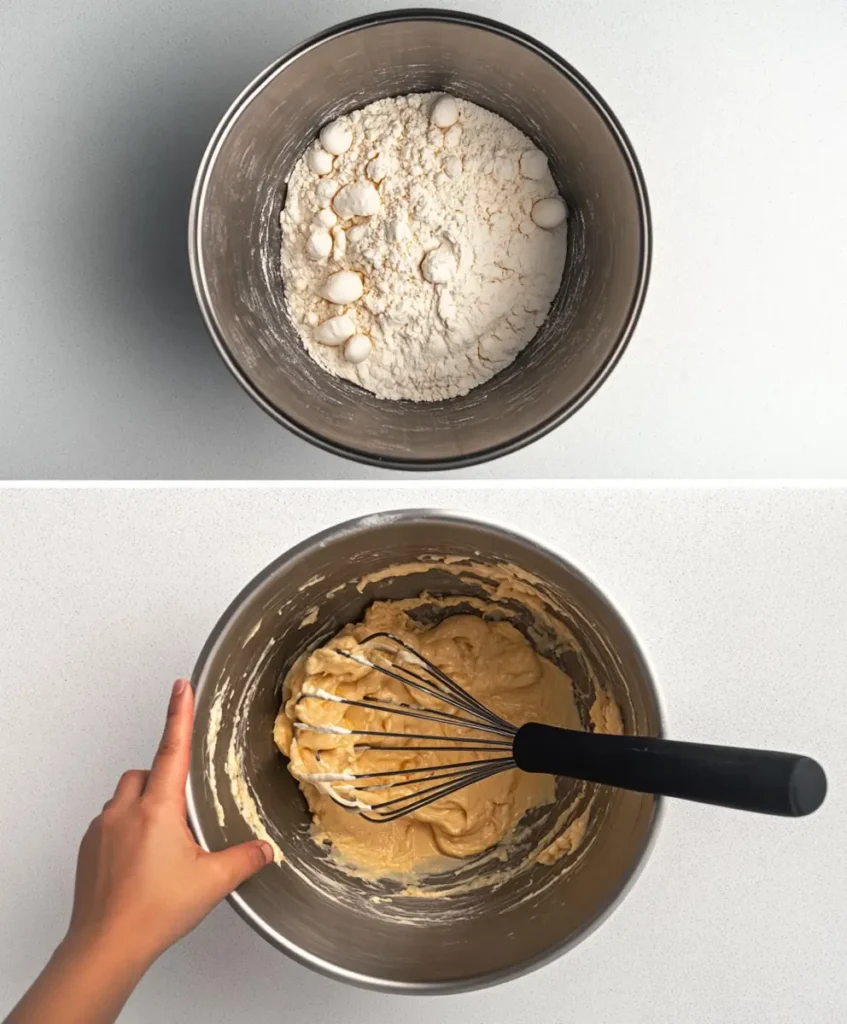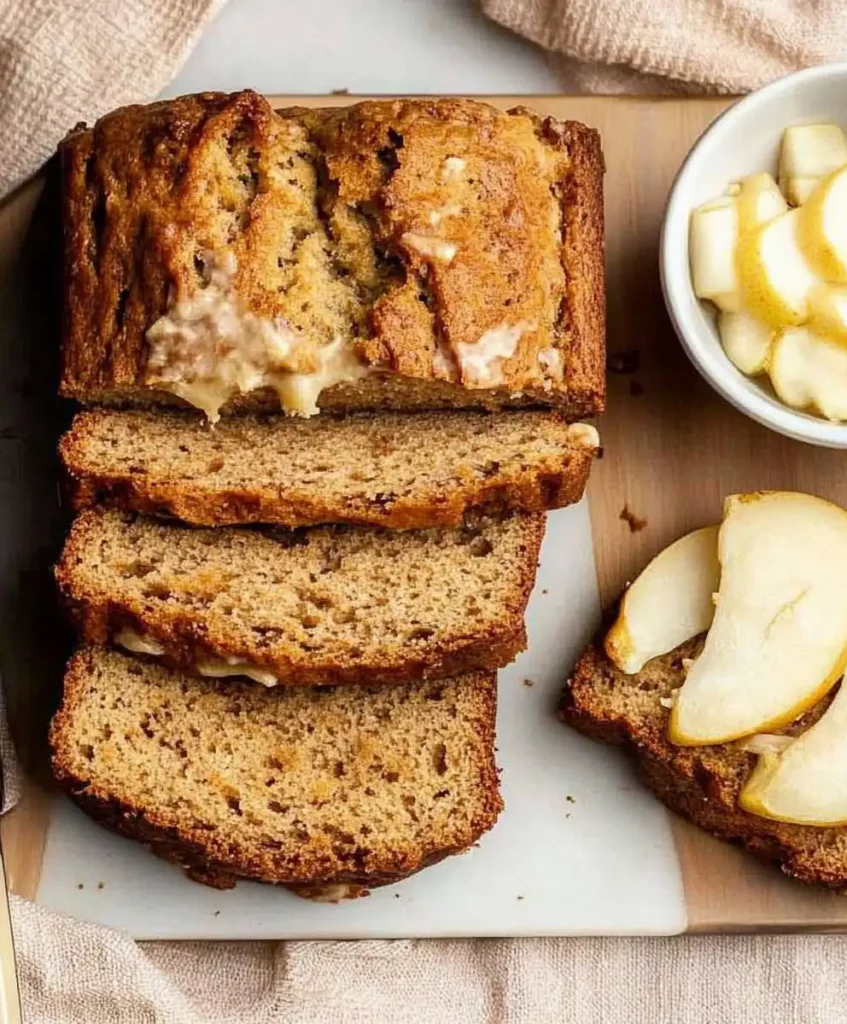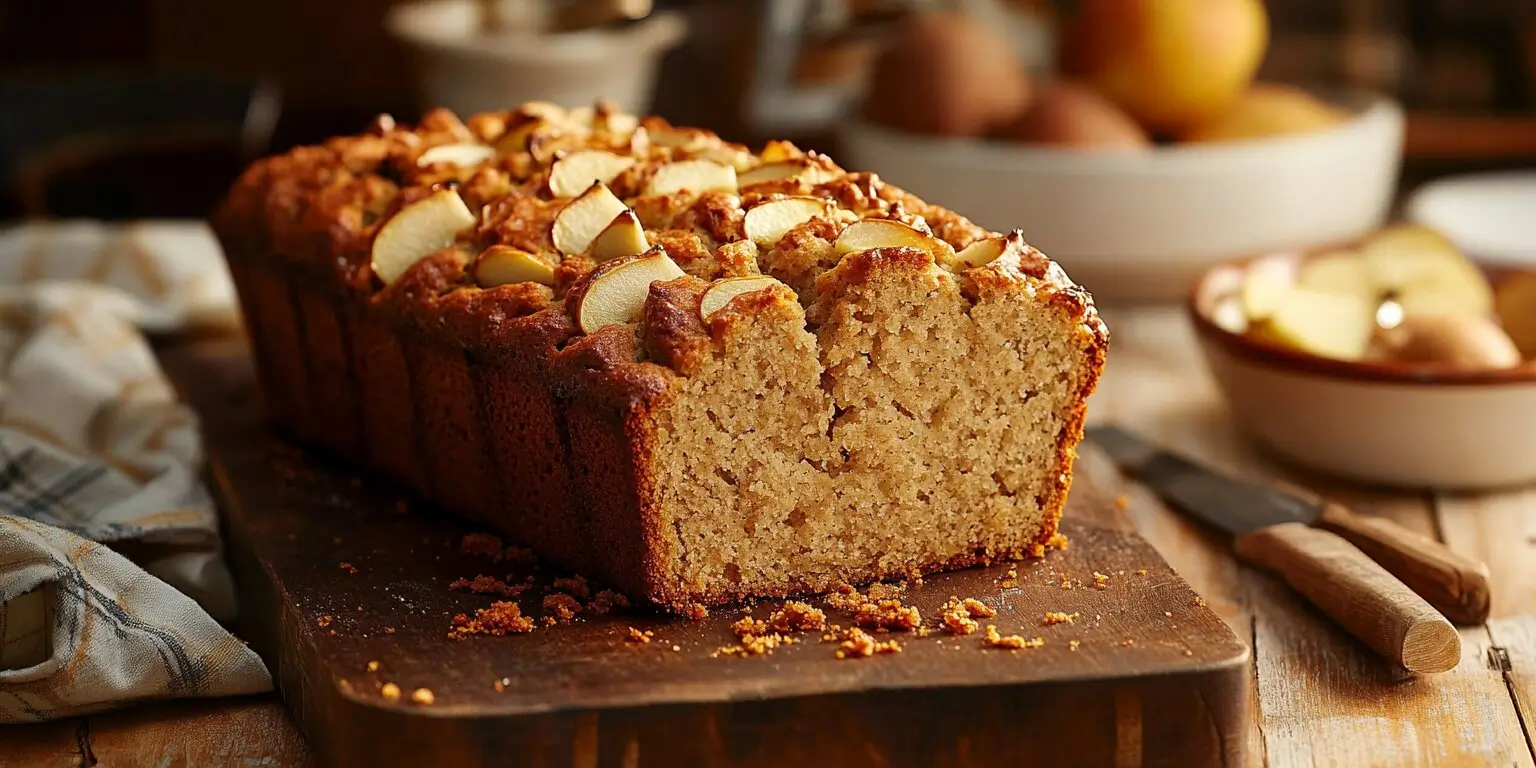There’s something magical about the aroma of freshly baked bread wafting through your home. Now, imagine that scent enhanced by the delicate sweetness of ripe pears, warm spices like cinnamon, and a perfectly moist texture. That’s exactly what this pear bread recipe brings to the table, a blend of comfort, nostalgia, and a flavor you’ll absolutely love.
Whether you’re a seasoned baker or a newbie looking for a foolproof recipe, this pear bread is a must-try treat. Not only is it incredibly easy to make, but it’s also versatile enough to suit any occasion, be it a cozy breakfast, a midday snack, or a dessert centerpiece at your family gathering.
But why pear bread, you ask? Well, pears add a unique texture and flavor to baked goods that other fruits simply can’t replicate. Plus, with their natural sweetness, they make the bread irresistibly moist and rich. In this article, we’ll walk you through every step of crafting this delightful treat, along with tips and tricks to elevate it even further.
So, grab your mixing bowl, and let’s get started on this mouthwatering journey to creating the best pear bread recipe you’ll ever try!
Table of contents
Why Pear Bread is a Must-Try Treat
Pear Bread vs. Other Quick Breads
When it comes to quick breads, options like banana bread and zucchini bread often steal the spotlight. But pear bread? It’s an underrated gem waiting to be discovered. While banana bread leans heavily on sweetness and zucchini bread adds a hint of earthiness, pear bread strikes a perfect balance with its subtle sweetness and fruity undertones.
The texture is another standout feature. Pears add a tender, almost velvety texture to the bread, making each bite melt in your mouth. Whether you’re baking for your family, friends, or just yourself (no judgment!), pear bread is guaranteed to impress with its unique flavor profile.
The Health Benefits of Pears
Beyond their delicious taste, pears bring a host of health benefits to this recipe. They’re packed with fiber, which aids digestion and keeps you feeling full longer. Pears are also a great source of vitamins C and K, as well as antioxidants that promote overall wellness.
Incorporating pears into your baking isn’t just about flavor—it’s about adding a nutritious twist to your treats. This makes pear bread a great option for those who want to indulge in something sweet while still making a healthier choice.
Comfort and Nostalgia of Baking
There’s no denying the comfort that comes from baking your own bread. The process of measuring ingredients, mixing batter, and watching it rise in the oven feels almost therapeutic. With pear bread, you’re not just baking a loaf; you’re creating a warm, nostalgic moment that brings people together.
Whether it’s a rainy afternoon or a cozy holiday morning, this recipe is perfect for filling your home with warmth and joy. Plus, it’s a fun way to involve kids in the kitchen, they’ll love mashing the pears or sneaking a taste of the batter!
Ingredients for Pear Bread Recipe
Before we dive into the process, let’s gather everything you’ll need. The beauty of this recipe lies in its simplicity, you won’t need any fancy equipment or hard-to-find ingredients.
Essential Ingredients
- Pears (2 cups, mashed or diced): The star of the show! Choose ripe, juicy pears for the best flavor.
- All-purpose flour (2 cups): Provides structure to the bread. You can also use whole wheat flour for a healthier twist.
- Granulated sugar (1 cup): Adds sweetness. You can substitute with brown sugar or coconut sugar for a deeper flavor.
- Vegetable oil (½ cup): Keeps the bread moist. Alternatives include melted butter or applesauce for a lower-fat option.
- Eggs (2 large): Bind the ingredients together and add richness.
- Baking powder (1 tsp) & baking soda (½ tsp): Ensure the bread rises beautifully.
- Cinnamon (1 tsp): Brings a warm, spicy note. Feel free to add nutmeg or ginger for extra flavor.
- Salt (½ tsp): Balances the sweetness and enhances the flavors.
- Vanilla extract (1 tsp): Adds depth and a hint of sweetness.
Optional Add-ons
- Chopped walnuts or pecans (½ cup): For a crunchy texture.
- Raisins or dried cranberries (¼ cup): Add bursts of fruity sweetness.
- Streusel topping: A mix of sugar, butter, and flour to create a crispy, sweet crust.
Step-by-Step Instructions for Perfect Pear Bread
Ready to bake? Follow these steps to create a moist, flavorful loaf of pear bread that’s sure to become a favorite in your home.

1. Prepare Your Ingredients
- Wash, peel, and core the pears. If you’re mashing them, use a fork or blender to create a smooth texture. For a chunkier bread, dice them into small pieces.
- Preheat your oven to 350°F (175°C) and grease a standard 9×5-inch loaf pan or line it with parchment paper for easy removal.
2. Mix the Wet Ingredients
- In a large mixing bowl, whisk together the sugar, eggs, and vegetable oil until smooth.
- Add the vanilla extract and prepared pears (mashed or diced) and stir until well combined.
3. Combine the Dry Ingredients
- In a separate bowl, sift together the flour, baking powder, baking soda, cinnamon, and salt.
- Gradually add the dry mixture to the wet ingredients, stirring gently until just combined. Avoid overmixing, as it can lead to dense bread.
4. Add Optional Ingredients
- If you’re using nuts, dried fruits, or a streusel topping, gently fold them into the batter at this stage. These add-ons enhance both the texture and flavor.
5. Bake the Bread
- Pour the batter into the prepared loaf pan, spreading it evenly.
- Bake for 55–65 minutes or until a toothpick inserted into the center comes out clean.
- If the top browns too quickly, cover it loosely with aluminum foil during the last 15 minutes of baking.
6. Cool and Serve
- Allow the bread to cool in the pan for 10 minutes before transferring it to a wire rack. Let it cool completely before slicing—this ensures a clean cut and preserves the moist texture.
Expert Tips for the Perfect Pear Bread
Even a simple recipe can benefit from a few expert techniques. These tips will help you bake a pear bread that’s consistently moist, flavorful, and visually appealing.
How to Achieve Moist Bread
- Use ripe pears: Ripe pears are naturally sweet and juicy, which makes the bread extra moist. Overripe pears work wonderfully as they blend easily into the batter.
- Don’t skimp on fat: Ingredients like vegetable oil, butter, or even yogurt add richness and ensure the bread doesn’t dry out.
- Measure carefully: Too much flour can make the bread dense and dry. Use the spoon-and-level method to measure flour accurately.
- Avoid overmixing: Once you combine the wet and dry ingredients, stir just until everything is incorporated. Overmixing can lead to tough bread.
Avoiding Common Mistakes
- Soggy bread: If your bread turns out soggy, it could be due to excess moisture in the pears. Pat the diced pears dry with a paper towel or reduce the liquid content slightly.
- Uneven baking: Ensure your oven temperature is accurate. Using a thermometer helps avoid hot spots that can cause uneven baking.
- Sticky slices: Let the bread cool completely before slicing. Warm bread tends to crumble or stick to the knife.
Flavor Enhancements and Variations
One of the best things about pear bread is its versatility. Here are a few creative twists to make the recipe your own:
1. Spiced Pear Bread
- Add ½ tsp of nutmeg or ground ginger along with cinnamon for a warming, spiced flavor.
2. Chocolate Chip Pear Bread
- Stir in ½ cup of dark or milk chocolate chips for a dessert-like twist.
3. Vegan Pear Bread
- Replace eggs with flax eggs (1 tbsp flaxseed meal + 2.5 tbsp water per egg). Use coconut oil or applesauce instead of butter.
4. Gluten-Free Pear Bread
- Use a gluten-free all-purpose flour blend instead of regular flour.
5. Streusel-Topped Pear Bread
- Combine 3 tbsp butter, 3 tbsp sugar, and 3 tbsp flour for a crumbly topping. Sprinkle it over the batter before baking for a crispy, sweet crust.
6. Pear and Apple Combo Bread
- Substitute half of the pears with grated apples for a unique flavor blend.
Serving Suggestions
Wondering how to enjoy your freshly baked pear bread? Here are some pairing ideas to take it to the next level:
- Breakfast: Serve a warm slice with a dollop of butter or cream cheese. Pair it with a cup of coffee or tea for a comforting morning treat.
- Snack: Enjoy a slice with a drizzle of honey or a smear of peanut butter for an energy-boosting snack.
- Dessert: Top with a scoop of vanilla ice cream or whipped cream for an indulgent dessert.

Pear bread also makes a thoughtful gift! Wrap it in parchment paper, tie it with a ribbon, and share it with friends and family.
Storage and Freezing Tips
Proper storage is key to keeping your pear bread fresh and flavorful for days. Here’s how you can store it effectively:
Short-Term Storage
- Room Temperature: Wrap the bread tightly in plastic wrap or place it in an airtight container. It will stay fresh for up to 3 days at room temperature.
- Reheating: To refresh the bread, warm a slice in the microwave for 10–15 seconds for that fresh-out-of-the-oven taste.
Long-Term Freezing
Pear bread freezes beautifully, making it a great option for meal prepping or saving leftovers.
How to Freeze Pear Bread
- Let the bread cool completely to avoid condensation, which can cause freezer burn.
- Wrap the loaf or individual slices in plastic wrap, followed by aluminum foil.
- Place the wrapped bread in a freezer-safe bag or container.
- Label the container with the date and store it in the freezer for up to 3 months.
How to Thaw and Serve
- Remove the bread from the freezer and let it thaw at room temperature for a few hours.
- For a quick option, microwave individual slices for 20–30 seconds.

Soft Pear Bread
Ingredients
- For the Pear Loaf:
- 1 cup Granulated Sugar
- ¾ cup Vegetable Oil canola or another neutral oil
- 2 large Eggs at room temperature
- 1 tsp Vanilla Extract
- 1 ½ cups All-Purpose Flour
- ½ tsp Baking Soda
- 2 tsp Ground Cinnamon
- Pinch of Salt
- 2 medium Pears cored and finely diced (preferably Bartlett; optionally toss with a little lemon juice to prevent browning)
- For the Brown Sugar Glaze:
- ⅓ cup Unsalted Butter
- ½ cup Brown Sugar packed (light or dark)
- 2 tsp Milk 2% fat or higher
- 1 tsp Vanilla Extract
- Pinch of Salt
Instructions
- Preheat & Prep:
- Preheat your oven to 350°F (or 325°F for convection). Grease and flour a loaf pan, and if using a standard pan, line the bottom with parchment paper (no need if using a silicone pan).
- Mix the Wet Ingredients:
- In a large bowl, whisk together the granulated sugar, vegetable oil, vanilla extract, and eggs until the mixture becomes smooth and glossy.
- Sift the Dry Ingredients:
- In a separate bowl, sift the all-purpose flour, ground cinnamon, baking soda, and a pinch of salt.
- Combine & Fold:
- Gradually fold the dry ingredients into the wet mixture until just combined. Gently stir in the diced pears until evenly distributed. The batter will be wet and studded with pear pieces.
- Bake:
- Pour the batter into the prepared loaf pan and smooth the top. Bake for about 60 minutes, or until a toothpick inserted into the center comes out clean (a few crumbs are okay). Allow the bread to cool in the pan.
- Prepare the Glaze:
- In a small saucepan over medium-low heat, melt the unsalted butter. Add the brown sugar and allow it to bubble gently at the edges while swirling the pan to avoid burning. Stir in the milk and continue swirling for 3–5 minutes until the mixture thickens slightly. Remove from heat and whisk in the vanilla extract and a pinch of salt. Let the glaze cool for about 5 minutes.
- Finish & Serve:
- Transfer the cooled bread to a serving plate. Drizzle the brown sugar glaze evenly over the top. Allow the glaze to set—if needed, refrigerate briefly to speed up the process. Slice, serve, and enjoy your super soft pear bread!
Notes
- Pear Preparation: For best results, toss diced pears with a splash of lemon juice to prevent browning if preparing ahead.
- Mixing Tips: Avoid overmixing once the flour is added to keep the bread tender and soft.
- Glaze Application: Drizzle the brown sugar glaze over the bread while it’s still warm for a more even coating, or chill briefly to speed up the setting process.
- Storage: Store leftovers in an airtight container at room temperature for up to 3 days, or freeze for longer storage.
- Variations: Experiment with additional spices such as nutmeg or ginger to add a unique twist to the classic flavor profile.
Frequently Asked Questions (FAQs)
1. What can I do with excess pears?
Excess pears can be used in various ways, such as making pear bread, pear preserves, pear crisps, or smoothies. You can also dice and freeze them for later use in recipes like pies or sauces.
2. What is the nutritional value of pear bread?
Pear bread typically contains vitamins from the pears, such as vitamin C and K, along with fiber. The nutritional value varies based on ingredients, but one slice may have around 150–200 calories, depending on added sugars or toppings.
3. What are the best pears for baking?
The best pears for baking include Bartlett, Anjou, and Bosc pears. These varieties hold their shape well during baking and provide natural sweetness and moisture to recipes like pear bread.
4. What is the most common fruit used for making quick breads?
Bananas are the most common fruit used for quick breads, as seen in the classic banana bread. However, pears, zucchini, and apples are also popular for adding unique flavors and textures.
5. Can I Add Other Fruits to This Recipe?
Definitely! You can combine pears with apples, bananas, or even cranberries for a unique twist. Just ensure the total fruit quantity remains the same for balanced moisture.
6. How Can I Make This Recipe Vegan-Friendly?
To make the recipe vegan:
- Replace eggs with flax eggs (1 tbsp flaxseed meal + 2.5 tbsp water per egg).
- Use coconut oil or applesauce instead of butter or regular oil.
Conclusion
There you have it, an irresistible pear bread recipe that’s as easy to make as it is delicious. With its moist texture, warm spices, and natural sweetness, this bread is sure to become a household favorite. Whether you’re looking for a comforting breakfast, a snack to enjoy with your afternoon tea, or a dessert to share with loved ones, pear bread delivers on all fronts.
What makes this recipe truly special is its versatility. You can personalize it with your favorite add-ons, like crunchy nuts or a sweet streusel topping, or even turn it into muffins for on-the-go treats. Plus, it’s a great way to use up those ripe pears sitting on your kitchen counter!
So why wait? Roll up your sleeves, preheat that oven, and let the delightful aroma of baking pear bread fill your home. We’re confident this recipe will not only satisfy your taste buds but also become a tradition you’ll come back to time and time again.
Happy baking! And don’t forget to share your pear bread creations with friends and family, they’ll love it just as much as you do.
Related Article Recipes You Might Like
If you’re looking for allergy-friendly meal ideas, check out What Can I Eat That Is Dairy and Egg Free?. You might also like Easy Irresistible Gluten and Dairy-Free Breakfast Ideas or Gluten-Free Crescent Rolls: A Complete Guide
